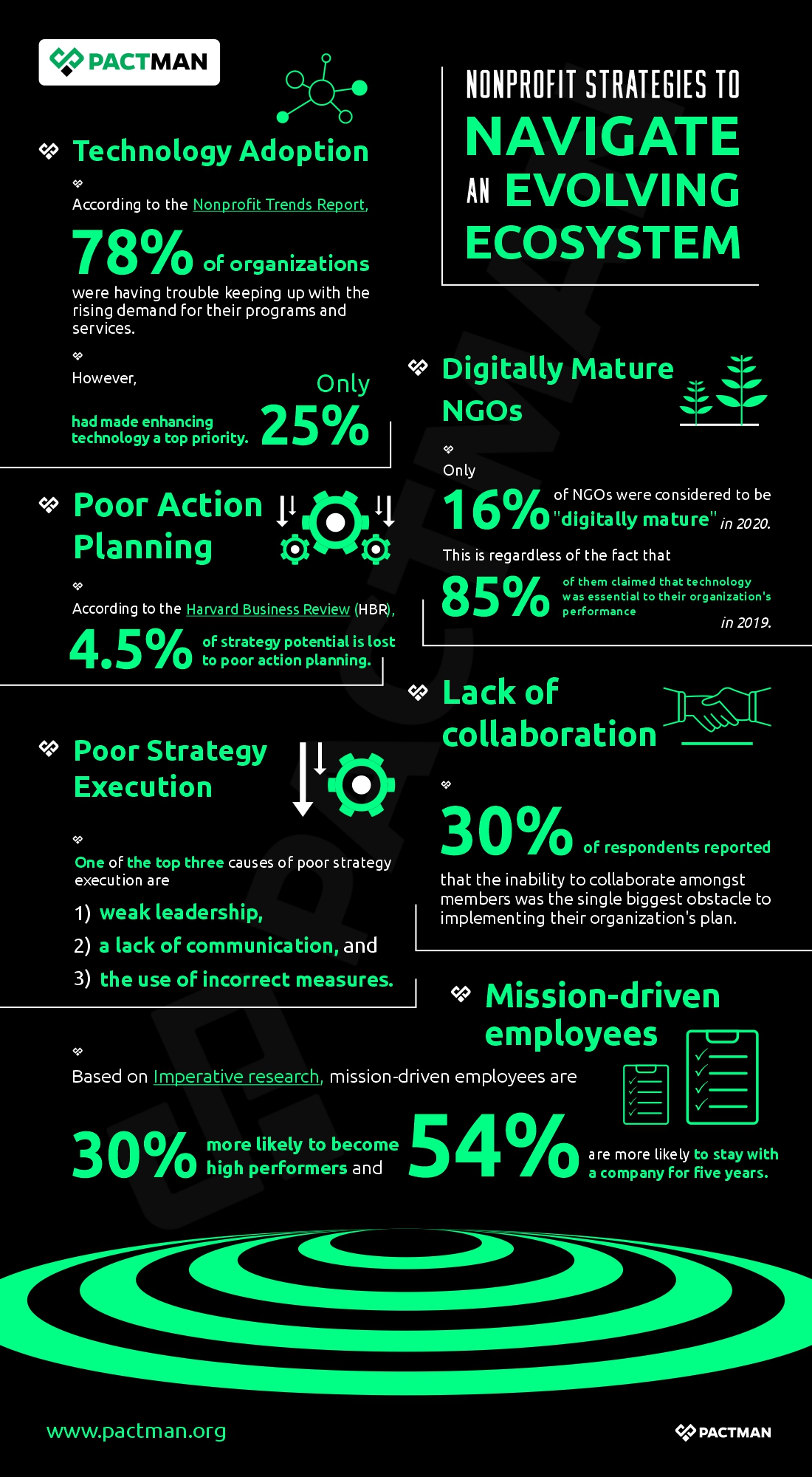I
Introduction
In terms of global transformation, nonprofit organizations have historically trailed behind for-profit corporations. Hence, nonprofit strategies can be a great way to aid organizations in advancing their goal and vision. Even more, it assists nonprofits in assessing their progress, areas of strength, and areas of improvement.

Organizations must be willing to constantly adapt to the unpredictable if they are to successfully manage the waves of rapid change that characterize the world we live in. By and large, an effective plan gives nonprofits the self-awareness, alignment, and decision-making capabilities they need to promote change. Likewise, NGOs can assess areas where they need to make improvements and determine how to improve the services they already offer or identify new service areas.
Strategic planning is also crucial for NGOs that seek to attain their objectives and deliver results. Through these objectives, nonprofits can develop unique action plans that support the needs of the organization while at the same time focusing on its overall mission and vision.
II
What is a Strategic Plan?
A strategic plan is a roadmap, a guide, and a focal point to steer an organization in an exact direction. Michael Allison and Jude Kaye provide a thorough definition in the book “Strategic Planning for Nonprofit Organizations.” In their words, a strategic plan “generates a clear knowledge of an organization’s mission, strategy, and organizational values among staff, board members, and external constituents.”

For the most part, the majority of strategic planning procedures are the results of stakeholder input. This also entails a careful evaluation of the organization’s distinctive value, networks, and position in the market. Likewise, planning is crucial to keep all staff members focused on the future. This also holds true for new organizations, NGOs seeking to rebuild, or already thriving nonprofits. Consequently, there tends to be clarity and progress when all teams participate. Likewise, board leaders must understand how their work contributes to the organization’s sustainability.
With a strategic plan, an organization can operate from a deliberate and proactive position rather than a reactive one. Furthermore, it simplifies decision-making and serves as a guide for achieving the organization’s goals.
III
Why is it Important to Identify Key Nonprofit Strategies?
NGOs can gain from nonprofit strategies in several ways. Firstly, organizations can better fulfill their missions, increase appeals on social media and attract funding by identifying specific, key objectives. A strategic plan can also determine what is required to make a project workable. All in all, an organization can focus on the present while still looking ahead by creating a good plan.

We will go further to analyze the inherent benefits of nonprofit strategies.
a. Enables organizations to prepare for the future:
As the saying goes; if you don’t know where you’re going, you’ll probably wind up somewhere else. A strategic plan lays out how an organization will take the necessary steps to accomplish its ideal goals. Besides, nonprofit strategies tend to foster alignment as it guides the entire members such as the board, staff, and volunteers.
During the planning process, it becomes easy to prioritize the work that needs to be done. Likewise, an organization can make short-term decisions based on long-term effects. Most importantly, a strategic plan offers a number of fortes regarding what must occur. It is a dynamic document that gives the organization flexibility so that, when change happens, the plan can be modified to take those changes into account.
b. Enhance the decision-making process
Planning minimizes stress by making decisions less difficult. Chiefly, the accomplishment of the organization’s vision is ensured by strategic decision-making and problem-solving initiatives.
A strategic plan will help organizations make decisions and solve problems on a daily basis that are directly tied to their long-term and short-term objectives. Likewise, the direction of the organization is made obvious when decisions are made within that framework. On the other hand, when a strategic framework is absent, unexpected changes can negatively impact the organization.
c. Provides consensus and clarity to the organization’s mission and vision
It is crucial that everyone understands the organization’s mission. As a rule, an organization cannot function effectively without this consensus. Likewise, during the strategic planning process, the staff, board members, and volunteers may have the opportunity to communicate and come to an agreement. The core of strategic planning is defining a shared vision (the organization’s future path) and then making preparations in accordance with that goal.
d. Provides foresight and techniques to manage changes
An organization can handle changes by predicting and planning for them rather than just responding to them. Hence, nonprofit strategies enable nonprofit organizations to foresee changes and prepare ahead of time. Also, with accurate planning, an organization becomes equipped to adapt to significant environmental shifts.
e. Encourages good stewardship:
Good stewardship calls for holding each person and their actions accountable. Strategic planning assists nonprofit organizations in carrying out their purposes and stewarding the public’s confidence. Comparable expectations are also held by association members, foundation board members, and grantees concerning the use of funds.
f. Unites the staff and board:
The foundation of a high-performance team is shared purpose and direction. In like manner, people experience a certain amount of synergy when they are focused on the same objective or result. They frequently put aside their differences, lend a hand to one another, and get motivated by a shared aim.
Likewise, an organization’s objective cannot be realized without the agreement of both staff and board members on a shared direction. In addition, all parties must be committed to achieving success.
The resources of an organization can be distributed more effectively once its strategic orientations and top priorities are made known. Furthermore, other essential areas include the leaders’ core future goals, the staff’s robust purpose, and direction, and increased engagement of stakeholders and constituents. A nonprofit organization is in a good position for success when it has a clear vision of what it wants for the future.
IV
What Should a Strategic Plan Entail?
We now understand how nonprofit strategies can aid in an organization’s growth and development. In this section, we will go further to outline the various aspects of a strategic plan. Not to mention, a strategic plan is most effective when everyone in the team recognizes its value and accords it with a high level of priority.

Likewise, every person who will contribute to achieving the goals should participate in planning and be part of the team that drafts the strategies.
Let us now go ahead to list in detail the various compartments of nonprofit strategies.
a. A specific goal
Writing concrete actions for reaching specific goals and outcomes is a crucial component of developing a strong nonprofit strategic plan. On the other hand, it would be challenging to achieve your goals if it’s not precise enough. A nonprofit plan should outline specific activities for specific individuals as well as the time frame.
b. A living document
By and large, a nonprofit strategic plan is also a living document. In the long run, your strategies might need to change since the internal and external environments that surround any nonprofit are constantly changing.
Also, while you may establish a strategic plan that maps out a three to five-year goal (depending on what type of planning model you use), it is crucial to regularly monitor and reevaluate your achievements and failures.
c. A time-bound strategy
Although a typical nonprofit strategic plan usually focuses on the next three to five years, you still need to be careful not to plan too far in advance. To be successful, your nonprofit must decide on a workable schedule that satisfies its unique aims and objectives.
Making a strategic plan is something you should undertake to ensure you can accomplish your set objectives, not merely pretend you have one.
Also, it will be challenging to comprehend how daily activities are actually affecting the organization’s achievement if preparations are made too far in advance. This in turn can potentially become stressful and hinder your nonprofit’s performance.
d. An effective team
A functioning board, which is still a rarity in corporations, is crucial for implementing a strategic plan. The team for your organization may just consist of the board of directors or include a larger staff. Although each person might not participate in every phase of the planning process, everyone should engage in some capacity. This is primarily because everyone takes part in carrying out the tasks necessary to achieve the set objectives.
For super effectiveness, some organizations have incorporated strategies even more uncommon. Among such includes a CEO whose performance is routinely evaluated by a board committee and who is clearly answerable to the board. Secondly, a board whose performance is evaluated yearly in comparison to predetermined performance goals. After all, organizing the duties and activities of a board is more effective than discussing its purpose.
V
Steps to Developing a Strategic Plan
To reiterate, everyone should have and use a strategic plan. If you don’t, you run the risk of losing your effectiveness. Likewise, nonprofit strategies are essential for successful NGOs.

According to a Harvard Business Review (HBR), 4.5% of strategy potential is lost to poor action planning. Also, 30% of respondents reported that the inability to collaborate amongst members was the single biggest obstacle to implementing their organization’s plan.
One of the top three causes of poor strategy execution is: 1) weak leadership, 2) a lack of communication, and 3) the use of incorrect measures.
When developing a strategic plan for the first time or updating an existing one, it’s crucial to discuss with and include the appropriate people. This includes senior executives, board members, and other important team members who can help the nonprofit succeed over the long term.
In this regard, let us go over the various processes for developing effective nonprofit strategies.
a. Evaluate your current situation
The first step is to evaluate where your organization is right now to determine the next course of direction. Next, you should align your strategic planning team. Start by truthfully answering some critical questions that pertain to your organization.
How prominent is your nonprofit? What is the total number of employees? What is your organization’s net worth annually? What group does your NGO intend to appeal to?
All things considered, money might not be your major motivator if you run a nonprofit organization. However, you need money to undertake your objectives and gain visibility. Hence, you must consider where you currently acquire your income.
Is your organization funded by the government? How effective has fundraising been historically? Who are your sponsors and contributors? What additional sources of income do you have? Have you thought of any potential revenue sources yet? What does the normal flow of your grant administration procedure look like?
Also, in strategic planning, stakeholder analysis is essential. You must be aware of both your internal and external stakeholders to understand how they can affect the success of your nonprofit. Likewise, team members who will directly benefit from the strategic plan are known as internal stakeholders. They are probably those who are already part of the planning team.
For the most part, external stakeholders are companies, clients, or other parties who support your business financially or in other ways. You will also need to thoroughly evaluate these entities.
Who are the principal internal and external stakeholders of your organization? Why do they trust your NGO? What does your organization require of them, such as work, money, promotion, etc.? Why does your nonprofit have confidence in these stakeholders?
SWOT Analysis
Next, perform a SWOT analysis to identify the internal strengths and weaknesses of your organization. This should also include the potential external threats and opportunities that may affect the success of your nonprofit. What distinguishes your nonprofit from other charities in the sector? What are the prior events that have had an impact on your organization’s success and why? Are there previous shortcomings that have hindered the organization from realizing its full potential?
Take time for a thorough evaluation to know the current standing of your nonprofit organization.
b. Assess your mission and vision statement
One of the first things nonprofits can learn from successful institutions is their concise missions and purposes. An effective mission and vision statement aligns an organization to take action. More importantly, it summarizes the particular methods for achieving the fundamental objectives.
An effective mission statement helps to structure your organization. It is also capable of preventing irregularities which is one of the most prevalent menaces across institutions. With a solid mission statement, nonprofits can avoid the scattering of their constantly scarce resources on activities that only appear “interesting” or “profitable”. Hence, all resources can be put into a relatively small number of fruitful endeavors.
Also, to effectively carry out a mission objective, an organization will require mission-driven employees. Based on imperative research, mission-driven employees are 30% more likely to become high performers and 54% are more likely to stay with a company for five years.
Therefore, critically evaluate the mission and objectives of your nonprofit as well as your employees. High-performance firms are largely mission-driven companies.
As said earlier, a mission statement should be concise and ought to capture your organization’s objectives. We will consider three nonprofit organizations with effective and concise mission statements.
The Nature Conservancy
“To make the highest possible impact on the climate and biodiversity crises between now and 2030, we’re developing breakthrough ideas, amplifying local leaders, and influencing policy.”
This is straightforward and also time-bound. Even more, the mission statement captures the target demographics. This makes it so easy for readers to know where the organization channels its resources.
Warrior Rising
“Empowering Veterans In Business
Warrior Rising empowers U.S. military veterans and their immediate family members by providing them opportunities to create sustainable businesses, perpetuate the hiring of fellow American veterans, and earn their future.”
This is also a concise mission statement that targets a specific class of people within a country.
NCBI
“NCBI is here to transform the lives of children and adults who are blind or vision impaired throughout Ireland, ensuring they have access to the same opportunities, rights, and choices as anyone else in society.”
NCBI’s mission statement also echoes a simple objective that empowers two classes of people: children and adults.
Hence, when outlining your mission statement, be sure to communicate your objectives in the first two sentences.
Next, you’ll want to define your nonprofit’s core values. These values should describe your organization as well as align with its mission and vision.
Here are a few core values that you can apply to your nonprofit: Loyalty, Integrity, Trustworthiness, Reliability, Innovation, Service, Teamwork, and Diversity.
c. Map out your strategic plan
By and large, your objectives and long-term goals make up the core of your strategic plan. Likewise, they also serve as the basis for your implementation strategy and eventually determine the success and effectiveness of your new strategy.
To begin, use the SWOT analysis to choose three primary strategic priorities at the very least. SWOT stands for strengths, weaknesses, opportunities, and threats. If your SWOT analysis, for instance, reveals that your nonprofit has limited sources of income, you can decide to prioritize “diversifying revenue streams” as a strategic objective.
d. Create SMART goals
Setting up SMART goals is one of the effective nonprofit strategies that can help you implement your new plan effectively. According to Bill Copeland, “the trouble with not having a goal is that you can spend your life running up and down the field and never score.” Nothing can be more true than this.
SMART stands for Specific, Measurable, Achievable, Relevant, and Time-bound. SMART is a powerful tool that gives you the clarity, drive, and concentration you need to reach your objectives. It can also increase your likelihood of achieving them by allowing you to specify your goals and pick a deadline.
Your SMART objective, for instance, can be to diversify your sources of income. Hence, you can specify the least number of resources you intend to add to your organization’s portfolio over a one to three-year period. In addition, you may want to outline the various grants your nonprofit will apply for and if it would be on a quarterly or yearly basis.
e. Put your plan into action
Upon creating your strategic plan, the next line of activity is to put it into action. This is one area that can be exciting and at the same time terrifying. However, you can be sure of the outcome of your nonprofit strategies as you launch your plan. Asana is one great way to quickly track, manage, and share your strategic efforts with teams and shareholders. The software’s goal-setting tool allows you to translate your strategic plan into concrete activities.
f. Embrace digital transformation
Digital transformation provides charity organizations with a route to success. This is also an effective way to boost general effectiveness, facilitate partnerships with donors and volunteers, and enhance communications to reach more audiences.
One of the main goals of nonprofit organizations is to foster social good. Likewise, the efficiency and openness that come with digital transformation can make a huge impact when it comes to achieving social goals. By adopting digital management tools, nonprofits can boost the impact and effectiveness of every one of their efforts.
According to the Nonprofit Trends Report, 78% of organizations were having trouble keeping up with the rising demand for their programs and services. However, only 25% had made enhancing technology a top priority. Not to mention, only 16% of NGOs were considered to be “digitally mature” in 2020. This is regardless of the fact that 85% of them claimed that technology was essential to their organization’s performance in 2019.
Now more than ever, nonprofit organizations need to embrace technology and make it a core component of their nonprofit strategies. Digital transformation for NGOs aims to maximize potential impact and service. This is also a great way to ensure efficiency while at the same time gaining a wider reach.
Conclusion
A strategic plan lays out a useful road map for the organization to follow. It also answers all why, what, where, who, when, and how goals can be accomplished by the organization. Hence, nonprofits should leverage a strategic plan to direct the management team in carrying out critical functions. This also helps to accomplish both short and long-term results while effectively using available resources.
Board members and other members of the leadership team often tend to worry that strategic planning may take too long, lead to unpleasant disputes, or result in a document that “sits on the shelf” unused. However, a solid strategic plan does not have to be extensive or take a year or more to establish. It rather helps a non-profit organization (NPO) stay on track with its goals in an environment where resources are always limited.
If you enjoyed reading this article, please share your comments and suggestions with us at the bottom of this post.



10 Responses